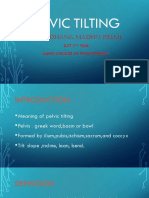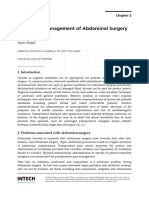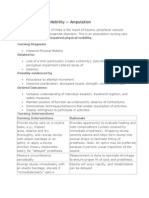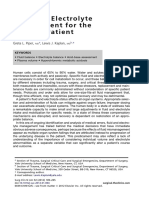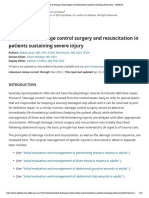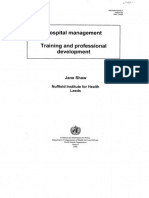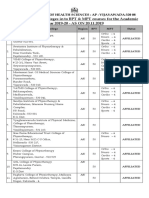Professional Documents
Culture Documents
Definition of Aquatic Exercise
Definition of Aquatic Exercise
Uploaded by
venkata ramakrishnaiahOriginal Description:
Copyright
Available Formats
Share this document
Did you find this document useful?
Is this content inappropriate?
Report this DocumentCopyright:
Available Formats
Definition of Aquatic Exercise
Definition of Aquatic Exercise
Uploaded by
venkata ramakrishnaiahCopyright:
Available Formats
Definition of Aquatic Exercise:
Aquatic exerciserefers to the use of water (in multidepth immersion
pools or tanks) that facilitates the application of established therapeutic
interventions, including stretching, strengthening, joint mobilization,
balance and gait training, and endurance training.
Aquatic exercise - specific goals:
■Facilitate range of motion (ROM) exercise
■Initiate resistance training
■Facilitate weight-bearing activities
■Enhance delivery of manual techniques
■Provide three-dimensional access to the patient
■Facilitate cardiovascular exercise
■Initiate functional activity replication
■Minimize risk of injury or re-injury during rehabilitation
■Enhance patient relaxation.
Precautions and Contraindications to Aquatic Exercise:
Fear of Water
Fear of water can limit the effectiveness of any immersed activity.
Fearful patients often experience increased symptoms during and after
immersion because of muscle guarding, stress response, and improper
form with exercise. Often patients require an orientation period
designed to provide instruction regarding the effects of immersion on
balance, control of the immersed body,and proper use of flotation
devices.
Neurological Disorders
Ataxic patients may experience increased difficulty controlling
purposeful movements. Patients with heat-intolerant multiple sclerosis
may fatigue with immersion in temperatures greater than 33°C.Patients
with controlled epilepsy require close monitoring during immersed
treatment and must be compliant with medication prior to treatment.
Respiratory Disorders
Water immersion may adversely affect the breathing of the patient with
a respiratory disorder. Lung expansion tends to be inhibited due to
hydrostatic pressure against the chest wall. Additionally, increased
circulation in the chest cavity may further inhibit lung expansion due to
increased circulation to the centre of the body. Maximal oxygen uptake
is lower during most forms of water exercise than during land exercise.
Cardiac Dysfunction
Patients with angina, abnormal blood pressure, heart disease, or
compromised pump mechanisms also require close monitoring.
Cider and colleagues demonstrated significant increases in work rate,
VO2peakand walking capacity, and muscle function in patients with
congestive heart failure and type 2 diabetes mellitus. Teffaha and
colleagues demonstrated similar results of increased VO2peak in
patients with chronic heart failure or coronary artery disease with
normal left ventricular function.
Small, Open Wounds and Lines
Small, open wounds and tracheotomies may be covered by waterproof
dressings. Patients with intravenous lines, Hickman lines, and other
open lines require proper clamping and fixation.
Precautions should also be exercised with patients having G-tubes and
suprapubic appliances. Observation for adverse reactions to aquatic
therapy is essential.
Contraindications
Contraindications to aquatic therapy include any situation creating the
potential for adverse effects to either the patient or the water
environment.
Such factors include:
■Incipient cardiac failure and unstable angina
■Respiratory dysfunction, vital capacity of less than 1 liter
■Severe peripheral vascular disease
■Danger of bleeding or hemorrhage
■Severe kidney disease (patients are unable to adjust to fluid loss during
immersion)
■Open wounds without occlusive dressings, colostomy, and skin
infections, such as tinea pedis and ringworm
■Uncontrolled bowel or bladder (bowel accidents require pool
evacuation, chemical treatment, and possibly drainage)
■Menstruation without internal protection
■Water and airborne infections or diseases (examples include influenza,
gastrointestinal infections, typhoid, cholera, and poliomyelitis)
■Uncontrolled seizures during the last year (they create a safety issue for
both clinician and patient if immediate removal from the pool is
necessary).
Properties of Water:
To utilize aquatics efficiently, practitioners must have a basic
understanding of the clinical significance of the static and dynamic
properties of water as they affect human immersion and exercise
You might also like
- Multiple-Choice QuestionsDocument38 pagesMultiple-Choice QuestionsVjs Mrunalini50% (6)
- Atls Chapter 8 Musculoskeletal TraumaDocument35 pagesAtls Chapter 8 Musculoskeletal TraumaPamorNo ratings yet
- Cardiac RehabilitationDocument9 pagesCardiac RehabilitationJisha JanardhanNo ratings yet
- Pelvic TiltingDocument28 pagesPelvic Tiltingvenkata ramakrishnaiahNo ratings yet
- Internal MedicineDocument167 pagesInternal MedicineJason Steel86% (7)
- Primary Health Care Hand Outs For StudentsDocument35 pagesPrimary Health Care Hand Outs For Studentsyabaeve100% (7)
- Management of Medically Compromised PatientsDocument31 pagesManagement of Medically Compromised PatientsRiyashi ChandaNo ratings yet
- HydrotherapyDocument14 pagesHydrotherapyKumaravel MuruganNo ratings yet
- Shock, Vascular AccessDocument58 pagesShock, Vascular Access20154712No ratings yet
- Care of The Patient in The Perioperative PeriodDocument20 pagesCare of The Patient in The Perioperative PeriodMohammed FaragNo ratings yet
- 4 Phases of IV Fluid Therapy FinalDocument29 pages4 Phases of IV Fluid Therapy FinalLuqmanul Hakim Junaidden100% (1)
- Anaesthesia Clerkship HandbookDocument12 pagesAnaesthesia Clerkship HandbookKay BristolNo ratings yet
- Stroke Rehabilitation. 2. Comorbidities and Complications: Elliot J. Roth, MD Stephen F. Noll, MD Abstract. RothDocument5 pagesStroke Rehabilitation. 2. Comorbidities and Complications: Elliot J. Roth, MD Stephen F. Noll, MD Abstract. RothInga HarghelNo ratings yet
- Fitness Issues For Divers With Musculoskeletal Problems Part1Document5 pagesFitness Issues For Divers With Musculoskeletal Problems Part1YuldashNo ratings yet
- Anestesi Abdominal ApproachDocument14 pagesAnestesi Abdominal ApproachabdulkadirmunsyNo ratings yet
- Study Guide:: DialysisDocument13 pagesStudy Guide:: DialysisDan Dan ManaoisNo ratings yet
- The Obese Patient. F o RDocument22 pagesThe Obese Patient. F o RsukolratingNo ratings yet
- Eisenmenger SyndromeDocument10 pagesEisenmenger SyndromeprastiaNo ratings yet
- BMJ g7620 FullDocument10 pagesBMJ g7620 FullRui PenedaNo ratings yet
- Intravenous Fluid CrystalloidsDocument34 pagesIntravenous Fluid CrystalloidsDebashish PaulNo ratings yet
- Pre and Post Operative ManagementDocument3 pagesPre and Post Operative Managementdrsb54No ratings yet
- Hf-Part Ii - 2024Document26 pagesHf-Part Ii - 2024عبدالقادر خليل خلفNo ratings yet
- Seminars 2019 PDFDocument200 pagesSeminars 2019 PDFpaingmyintNo ratings yet
- Consider Abdominal Compartment Syndrome in Patients With Refractory HypotensionDocument26 pagesConsider Abdominal Compartment Syndrome in Patients With Refractory HypotensionHari AdityonugrohoNo ratings yet
- 100 Questions 100 Answers Volume No2Document105 pages100 Questions 100 Answers Volume No2897829No ratings yet
- Pre-Operative Nursing CareDocument79 pagesPre-Operative Nursing CarePeter FrimpongNo ratings yet
- Excess Fluid Volume HypervolemiaDocument7 pagesExcess Fluid Volume HypervolemiaLuthfiy IrfanasruddinNo ratings yet
- NCPDocument8 pagesNCPJose Benit DelacruzNo ratings yet
- SHOCKDocument17 pagesSHOCKChithra Saju100% (1)
- Perioperative Intravenous Fluid Therapy For Adults: Rob Mac Sweeney, Rachel Alexandra Mckendry, Amit BediDocument8 pagesPerioperative Intravenous Fluid Therapy For Adults: Rob Mac Sweeney, Rachel Alexandra Mckendry, Amit BediAnnisa Chaerani BurhanuddinNo ratings yet
- Posoperatorio ObstructivaDocument7 pagesPosoperatorio ObstructivacrisordNo ratings yet
- Preoperative PreparationsDocument26 pagesPreoperative PreparationsReda IsmaeelNo ratings yet
- 6-Pharm Care Pada Terapi CairanDocument34 pages6-Pharm Care Pada Terapi CairanApt RatnaningrumNo ratings yet
- Komplikasi Intra HDDocument8 pagesKomplikasi Intra HDinfo.astryputriNo ratings yet
- Perioperative Care For Kidney Patients: KeywordsDocument6 pagesPerioperative Care For Kidney Patients: KeywordsAziil LiizaNo ratings yet
- Pi Is 0039610912000163Document17 pagesPi Is 0039610912000163Hend Al-DreesNo ratings yet
- Principles of SurgeryDocument87 pagesPrinciples of SurgeryfiansisNo ratings yet
- Maintaining Fluid Balance: Barbara WorkmanDocument8 pagesMaintaining Fluid Balance: Barbara WorkmanNurul HendrianiNo ratings yet
- Endocrine NursingDocument28 pagesEndocrine Nursingatufail112233No ratings yet
- HEMODIALYSISDocument2 pagesHEMODIALYSISRya Pahilan MirandaNo ratings yet
- Nejm How To PericardiocentesisDocument5 pagesNejm How To Pericardiocentesispkapur8552No ratings yet
- Fluids SummaryDocument3 pagesFluids Summarymicheal1960No ratings yet
- Medical EmergenciesDocument15 pagesMedical EmergenciesDrBhawna AroraNo ratings yet
- Intravenous Fluids PDFDocument10 pagesIntravenous Fluids PDFGReadRNo ratings yet
- Drowning in Adult PopulationDocument31 pagesDrowning in Adult PopulationKamini VinathanNo ratings yet
- DM NCPDocument8 pagesDM NCPCaress Mae Gubaton CabudoyNo ratings yet
- Critical Care PASSTHEMRCSDocument131 pagesCritical Care PASSTHEMRCSthinzarNo ratings yet
- OB:Gyn DialysisDocument3 pagesOB:Gyn Dialysisfaisal alharbiNo ratings yet
- HEMODAILYSIS BiologyDocument4 pagesHEMODAILYSIS BiologylikithNo ratings yet
- Fluid and Electrolyte Management For The Surgical PatientDocument17 pagesFluid and Electrolyte Management For The Surgical PatientFery López NavedaNo ratings yet
- 8.anesthesia For Abdominal SurgeryDocument35 pages8.anesthesia For Abdominal Surgerykarim hassanNo ratings yet
- Management of Critically Ill Patients in The ICUDocument55 pagesManagement of Critically Ill Patients in The ICUkader abdiNo ratings yet
- Flipped Classroom HemodialysisDocument9 pagesFlipped Classroom HemodialysisJerika Ina SamsonNo ratings yet
- Severe Dengue in ICUDocument35 pagesSevere Dengue in ICUanaeshklNo ratings yet
- 272 Liver Disease Part 2Document7 pages272 Liver Disease Part 2Aliyu Bashir AdamuNo ratings yet
- Study Guide:: DialysisDocument8 pagesStudy Guide:: DialysisDan Dan ManaoisNo ratings yet
- Guillain-Barre Syndrome Treatment & Management: Approach ConsiderationsDocument8 pagesGuillain-Barre Syndrome Treatment & Management: Approach ConsiderationsStephanie Mhae TabasaNo ratings yet
- Lesson 5: Drowning:: Death From Suffocation Resulting From Aspiration of Water or Other Substance or FluidDocument4 pagesLesson 5: Drowning:: Death From Suffocation Resulting From Aspiration of Water or Other Substance or FluidHelena FarroNo ratings yet
- Overview of Damage Control Surgery and Resuscitation in Patients Sustaining Severe Injury - UpToDateDocument28 pagesOverview of Damage Control Surgery and Resuscitation in Patients Sustaining Severe Injury - UpToDateelhierofanteNo ratings yet
- Septic Shock TreatmentDocument22 pagesSeptic Shock TreatmentAdreiTheTripleA100% (1)
- Trauma Assessment: Aims of The Initial Evaluation of Trauma PatientsDocument6 pagesTrauma Assessment: Aims of The Initial Evaluation of Trauma Patientsece142No ratings yet
- Written Report On MS - Valvular Heart DisordersDocument8 pagesWritten Report On MS - Valvular Heart DisordersJan SaldoNo ratings yet
- Nursing Diagnosis Fluid ExcessDocument8 pagesNursing Diagnosis Fluid ExcessLuthfiy IrfanasruddinNo ratings yet
- Critical Care Common Conditions: Critical Care EssentialsFrom EverandCritical Care Common Conditions: Critical Care EssentialsNo ratings yet
- Physiotherapy in Autism ManagementDocument5 pagesPhysiotherapy in Autism Managementvenkata ramakrishnaiahNo ratings yet
- Hospital Management - Training and Professional DevelopmentDocument46 pagesHospital Management - Training and Professional Developmentvenkata ramakrishnaiahNo ratings yet
- Behavioral & Learning Problems in The Disabled: DR Venkata Ramaiah ValluriDocument29 pagesBehavioral & Learning Problems in The Disabled: DR Venkata Ramaiah Vallurivenkata ramakrishnaiahNo ratings yet
- Occupational Therapy For Spinal Cord Injury PatientsDocument8 pagesOccupational Therapy For Spinal Cord Injury Patientsvenkata ramakrishnaiahNo ratings yet
- Peripheral Nerve Injury in Upper LimbDocument29 pagesPeripheral Nerve Injury in Upper Limbvenkata ramakrishnaiahNo ratings yet
- Introduction To NeurophysiologyDocument13 pagesIntroduction To Neurophysiologyvenkata ramakrishnaiahNo ratings yet
- Isometric Exercise (Static Exercise)Document18 pagesIsometric Exercise (Static Exercise)venkata ramakrishnaiah100% (3)
- Proprioceptive Neuromuscular FacilitationDocument69 pagesProprioceptive Neuromuscular Facilitationvenkata ramakrishnaiah100% (1)
- Sensory IntegrationDocument14 pagesSensory Integrationvenkata ramakrishnaiahNo ratings yet
- Medical Case Sheet: Ayushman Bharat Niramayam' Madhya PradeshDocument11 pagesMedical Case Sheet: Ayushman Bharat Niramayam' Madhya Pradeshvenkata ramakrishnaiahNo ratings yet
- Hansen's Disease (Leprosy) : Dr. Venkata Ramaiah.V MPT OrthoDocument72 pagesHansen's Disease (Leprosy) : Dr. Venkata Ramaiah.V MPT Orthovenkata ramakrishnaiahNo ratings yet
- PNF Techniques by RamDocument52 pagesPNF Techniques by Ramvenkata ramakrishnaiah100% (1)
- Uw Health Job Description: Transplant Coordinator Job SummaryDocument4 pagesUw Health Job Description: Transplant Coordinator Job Summaryvenkata ramakrishnaiahNo ratings yet
- Muscle Re-Education by Venkata RamaiahDocument8 pagesMuscle Re-Education by Venkata Ramaiahvenkata ramakrishnaiahNo ratings yet
- Suspension Therapy by Rahul Vapms CopDocument20 pagesSuspension Therapy by Rahul Vapms Copvenkata ramakrishnaiahNo ratings yet
- Determinants RESISTED EX'SDocument24 pagesDeterminants RESISTED EX'Svenkata ramakrishnaiahNo ratings yet
- Resisted Ex'sDocument109 pagesResisted Ex'svenkata ramakrishnaiahNo ratings yet
- Barriers in The Implementa-Tion of Health Information Systems: A Scoping ReviewDocument18 pagesBarriers in The Implementa-Tion of Health Information Systems: A Scoping Reviewvenkata ramakrishnaiahNo ratings yet
- Adhi Lakshmi (MMT)Document35 pagesAdhi Lakshmi (MMT)venkata ramakrishnaiahNo ratings yet
- Barriers For The Using of Information Systems in Hospitals: A Qualitative StudyDocument6 pagesBarriers For The Using of Information Systems in Hospitals: A Qualitative Studyvenkata ramakrishnaiahNo ratings yet
- Adhi Lakshmi (MMT)Document35 pagesAdhi Lakshmi (MMT)venkata ramakrishnaiahNo ratings yet
- Co-Ordination: Prepared by Ahmed Shawky AliDocument59 pagesCo-Ordination: Prepared by Ahmed Shawky Alivenkata ramakrishnaiahNo ratings yet
- 2 Amputation ExplainedDocument16 pages2 Amputation Explainedvenkata ramakrishnaiahNo ratings yet
- Ambulation Aids and Patterns 2018Document59 pagesAmbulation Aids and Patterns 2018venkata ramakrishnaiah100% (1)
- Physiotherapy Affiliated Colleges List - Under NtruhsDocument3 pagesPhysiotherapy Affiliated Colleges List - Under Ntruhsvenkata ramakrishnaiah100% (2)
- Lead TimeDocument82 pagesLead Timevenkata ramakrishnaiahNo ratings yet
- Tendon Transfers: by DR Krishna BhattDocument89 pagesTendon Transfers: by DR Krishna Bhattvenkata ramakrishnaiahNo ratings yet
- Walkingaids 180118043224Document74 pagesWalkingaids 180118043224venkata ramakrishnaiahNo ratings yet
- Pathology+101 Complete)Document147 pagesPathology+101 Complete)Goh Kah Yong100% (2)
- Management of Patients With Systemic Diseases in Oral SurgeryDocument42 pagesManagement of Patients With Systemic Diseases in Oral SurgeryRichard Starr100% (2)
- CPG Management of Percutaneous Coronory Intervention (PCI) 2009Document92 pagesCPG Management of Percutaneous Coronory Intervention (PCI) 2009umiraihana1No ratings yet
- Hypertension: Department of Internal MedicineDocument58 pagesHypertension: Department of Internal MedicineLouije MombzNo ratings yet
- AspirinDocument61 pagesAspirinMarta Halim100% (1)
- Literature Review On Hypertension and DiabetesDocument8 pagesLiterature Review On Hypertension and Diabetesafmabhxbudpljr100% (1)
- AO No. 2007-0025 PEME For Seafarers Related Documents PDFDocument26 pagesAO No. 2007-0025 PEME For Seafarers Related Documents PDFmariaNo ratings yet
- Gabe - Health, Medicine and RiskDocument8 pagesGabe - Health, Medicine and RiskMarceloCastellanosNo ratings yet
- NfiDocument41 pagesNfiKristine Singson0% (1)
- Common Problems in Cardiology (2016) (UnitedVRG)Document332 pagesCommon Problems in Cardiology (2016) (UnitedVRG)Pisica ZmeuNo ratings yet
- Medical Equipment Manufacturing Business Plan ExampleDocument36 pagesMedical Equipment Manufacturing Business Plan ExampleSofia Shanli San JoseNo ratings yet
- Stroke Clinical PathwayDocument35 pagesStroke Clinical PathwayLaurencia Leny100% (2)
- Score de FraminghamDocument2 pagesScore de FraminghamKarol CammtzNo ratings yet
- (Tips and Tricks) Shuvanan Ray - Tips and Tricks in Interventional Cardiology-Jaypee Brothers Medical Publishers (2015)Document204 pages(Tips and Tricks) Shuvanan Ray - Tips and Tricks in Interventional Cardiology-Jaypee Brothers Medical Publishers (2015)TRẦN VIẾT AN100% (1)
- Aapi Guide To Nutrition Health and Diabetes PDFDocument188 pagesAapi Guide To Nutrition Health and Diabetes PDFaquamaverickNo ratings yet
- Abstract Book INAACCDocument83 pagesAbstract Book INAACCrodtobingNo ratings yet
- Mean Platelet Volume and Coronary Artery Disease: ReviewDocument9 pagesMean Platelet Volume and Coronary Artery Disease: ReviewAlamgirNo ratings yet
- Yashwanth - IHD HFrEfDocument16 pagesYashwanth - IHD HFrEfYashwanth N BNo ratings yet
- Case 3 Ms Rle ArcayanDocument11 pagesCase 3 Ms Rle ArcayanVictoria Mae Irong CabahugNo ratings yet
- Cardiovascular System Block BookDocument38 pagesCardiovascular System Block BookJaneLorensNo ratings yet
- Daftar Pustaka: Fakultas Kedokteran Universitas AndalasDocument7 pagesDaftar Pustaka: Fakultas Kedokteran Universitas AndalasNavisa HaifaNo ratings yet
- Coronary Microvascular Disease Pathogenic Mechanisms and Therapeutic OptionsDocument17 pagesCoronary Microvascular Disease Pathogenic Mechanisms and Therapeutic OptionsZuleynny TellesNo ratings yet
- Materi Hipertensi Dr. Irma W, SP - PDDocument56 pagesMateri Hipertensi Dr. Irma W, SP - PDFina Syahrotul AdzimahNo ratings yet
- Natural Remedies For Heart DiseaseDocument8 pagesNatural Remedies For Heart DiseaseNur HowladerNo ratings yet
- Nayeli Sierra Ga FinalDocument7 pagesNayeli Sierra Ga Finalapi-300744043No ratings yet
- cILOSTAZOL 2Document10 pagescILOSTAZOL 2Muslih KerenNo ratings yet
- Cardiology Lectures 1 4 DR - Deduyo PDFDocument31 pagesCardiology Lectures 1 4 DR - Deduyo PDFMiguel Cuevas DolotNo ratings yet



